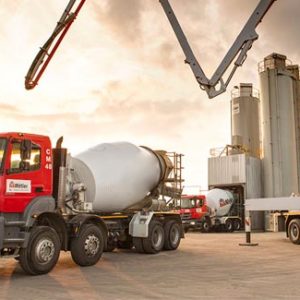A feasibility study for a ready-mix concrete factory with an investment of $10.5 million, where the project involves producing ready-mix concrete. Ready-mix concrete is a heterogeneous mixture of sand, gravel, cement, and water, with the option to add other materials (additives) to achieve specific properties.

The ready-mix concrete factory is a project focused on producing ready-mix concrete—a non-homogeneous mixture of sand, gravel, cement, and water, with the option of adding various admixtures to achieve specific properties. The proportions of these components are determined based on the type of construction work required and the availability of materials. Once mixed, the concrete begins to gradually harden over time, becoming strong and solid. Its final strength depends on the core components, the mixing process during pouring, and the type of curing and chemical enhancers used.
The idea behind the project stems from the continuous demand for ready-mix concrete and the significant boom across industrial and residential sectors due to ongoing urban development. This has led to a growing need for ready-mix concrete in construction, making this project increasingly viable. The availability of essential raw materials—cement, sand, gravel, and additives—also contributes to the stability of the production process.
The primary goal of the project is to meet the demands of the region, given the extensive urban expansion, and to leverage all the elements of sustainable development. The target market includes local contracting companies, real estate investment firms, and independent contractors.



Executive summary
Study project services/products
Market Size Analysis
Risk Assessment
Technical study
Financial study
Organizational and administrative study

Given the importance of the sector, “Mashroo3k” presents below the key performance indicators of the construction and building sector in the Gulf Cooperation Council (GCC) countries:
The Gross Domestic Product (GDP) of the construction and building sector: SAR 168.75 billion
Sector’s contribution to GDP: 4.66%
Number of companies operating in the sector: 148,026
Number of employees in the sector: 3,541,977
Value of projects implemented in the sector (according to the latest statistics): SAR 311.56 billion
Saudi Arabia ranks first in the region as the largest construction market, with an annual value exceeding USD 100 billion
GDP of the construction and building sector: AED 123.95 billion
Sector’s contribution to GDP: 8.3%
Number of companies operating in the sector: 42,428
Number of employees in the sector: 1,564,095
GDP of the construction and building sector: BHD 936.79 million
Sector’s contribution to GDP: 7.7%
In 2016, the sector’s value did not exceed BHD 857 million, but it has since increased over a few years to reach BHD 945.51 million
GDP of the construction sector: OMR 1.943 billion
Sector’s contribution to GDP: 6.7%
Number of employees in the sector: 548,999
The construction sector accounts for the highest percentage of Omani workers in both public and private sectors (22.4%), and 29.6% of the total expatriate workforce in the country
GDP of the construction and building sector: KWD 838.9 million
Sector’s contribution to GDP: 2.14%
Number of companies operating in the sector: 1,502
Number of employees in the sector: 187,705
GDP of the construction and building sector: QAR 81.22 billion
Sector’s contribution to GDP: 12.1%
Number of companies in the sector: 5,629
Number of employees: 840,999
The construction and building sector accounts for over 40% of Qatar’s economically active adult population
The construction and building sector is one of the most promising sectors in the region. There is no doubt that investing in its activities will be highly rewarding in the future. The increasing population and the ongoing improvement of infrastructure across the GCC will make this sector a prime destination for investors and entrepreneurs seeking high returns with minimal hassle.
Experts expect the market to grow at a rate of 4.2% over the next three years, with market value projected to reach USD 10.5 trillion by 2023.
In 2020, the global construction output was estimated at around USD 10.7 trillion, and it is expected to grow by 42% (an increase of USD 4.5 trillion) between 2020 and 2030, reaching USD 15.2 trillion by the end of the decade.

The construction and building sector contributes approximately 13% to the global Gross Domestic Product (GDP), and this share is expected to increase to 13.5% by 2030.
According to the available statistics, infrastructure is projected to top the list of the fastest-growing subsectors within the construction and building industry, with an estimated growth rate of 4% during the period from 2020 to 2030.